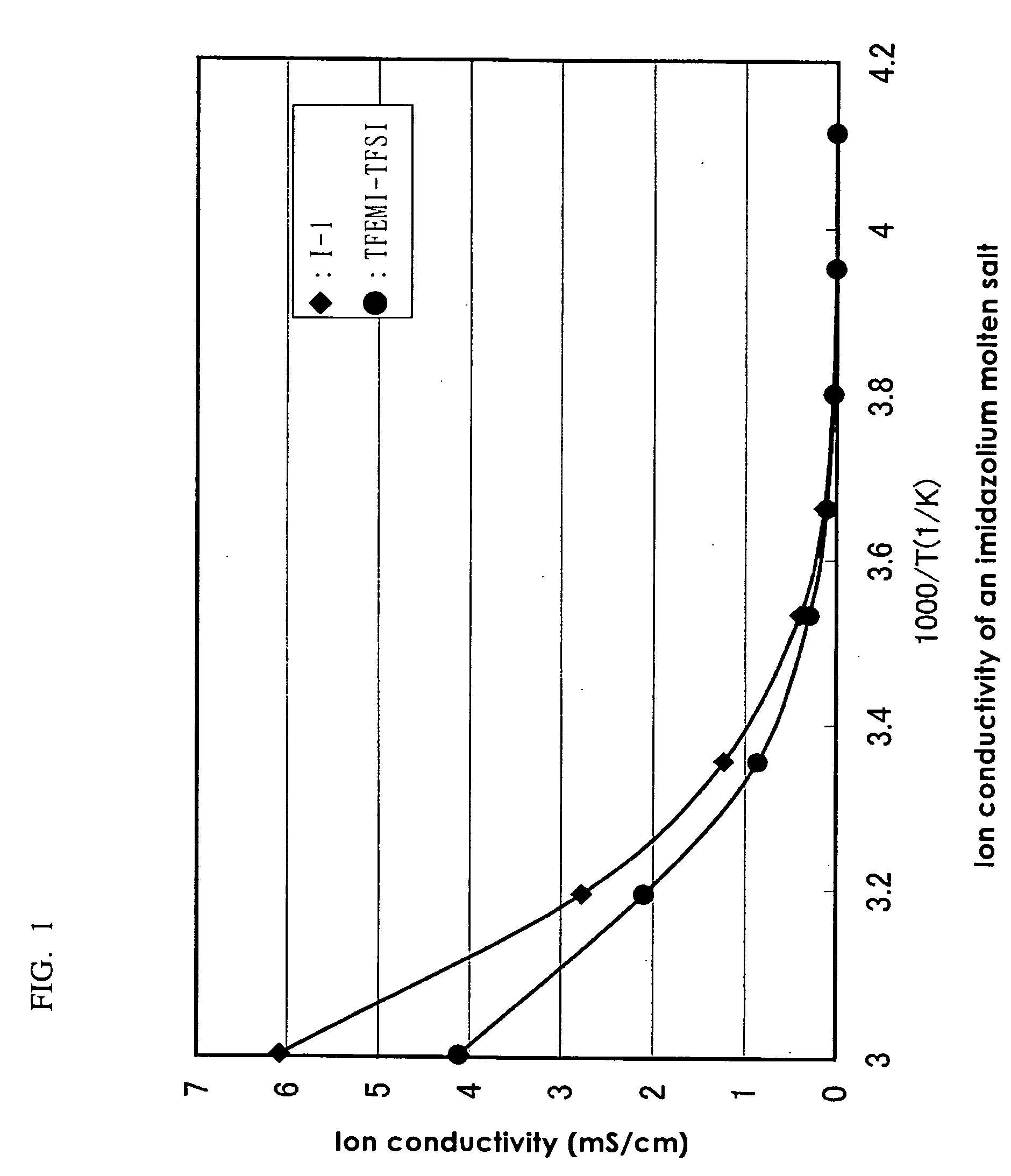Ambient-temperature molten salts and process for producing the same
a technology of ambient temperature and molten salts, applied in the field of compounds, can solve the problems of difficulty in obtaining a highly purified product, disadvantageous isolation or purification of the product, and serious deficiency of the conventional method, and achieve the effects of high efficiency, easy production of ambient temperature molten salts, and high yield
- Summary
- Abstract
- Description
- Claims
- Application Information
AI Technical Summary
Benefits of technology
Problems solved by technology
Method used
Image
Examples
example 1
Production of (fluoroalkyl)(fluorophenyl)iodonium imide (compound 1)
[0075]
[0076] CF3CH2I(OCOCF3)2 (43.6 g, 100 mmol), HN(SO2CF3)2 (28.1 g. 100 mmol), and dried methylene chloride (125 ml) were placed in a reaction vessel, the content of the reaction vessel was subjected to nitrogen substitution, and the mixed solution was stirred at room temperature for 30 minutes. The resultant was cooled in a bath at 0° C., and fluorobenzene (14.2 ml, 150 mmol) was then added dropwise thereto while stirring over the course of 2 minutes. Thereafter, the temperature of the bath was slowly raised to room temperature, and the mixture was allowed to react at room temperature for 20 hours.
[0077] After the completion of the reaction, the solvent was removed by distillation using an evaporator at room temperature, and trifluoroacetic acid as a side product was then removed by sucking with a vacuum pump. The obtained crystalline product was dissolved in a minimal amount of acetonitrile, and chloroform / et...
example 2
Production of (fluoroalkyl)(fluorophenyl)iodonium imide (compound 2)
[0079]
[0080] Compound 2 was obtained in the same manner as in Example 1, except for the use of CF3CH2I(OCOCF3)2 (21.8 g, 50 mmol), fluorobenzene (7.05 ml, 75 mmol), and HN(SO2CF2CF3)2 (19.1 g, 50 mmol) as starting materials and CClF2CCl2F (100 ml) as a solvent (yield 56%).
[0081] Melting point: 79.5-80.5° C. 1H-NMR (in CD3CN, ppm): δ 8.15 (dd, J=9, 5 Hz, o-H), 7.36 (t, J=9 Hz, m-H), 4.76 (q, J=10 Hz, CH2) 19F-NMR (internal standard: C6F6, in CD3CN, ppm): δ 101.4 (t, J=10 Hz, CF3CH2), 84.5 (s, CF3), 60.0 (m, p-F), 46.2 (s, CF2S) IR (cm-1): 1215 (SO2), 1348 (SO2) Elemental analysis: found: C,20.95%; H,1.05%; N,2.08%. calculated: C,21.04%; H,0.88%; N,2.04%.
example 3
Production of (fluoroalkyl)(fluorophenyl)iodonium imide (compound 3)
[0082]
[0083] Compound 3 was obtained in the same manner as in Example 1, except for the use of CF3CF2CH2I(OCOCF3)2 (4.86 g, 10 mmol), fluorobenzene (1.41 ml, 15 mmol), and HN(SO2CF3)2 (2.81 g, 10 mmol) as starting materials and CCIF2CCl2F (20 ml) as a solvent (yield 72%).
[0084] Melting point: 91.0-93.0° C. 1H-NMR (in CD3CN, ppm): δ 8.17(dd, J=9, 4 Hz, o-H), 7.36(t, J=9 Hz, m-H), 4.78(t, J=17 Hz, CH2) 19F-NMR (internal standard: C6F6, in CD3CN, ppm): δ 84.1 (s, CF3S), 80.3 (s, CF3), 60.0 (m, p-F), 55.5 (t, J=17 Hz, CF2) IR (cm-1): 1199 (SO2), 1346 (SO2) Elemental analysis: found: C,20.63%; H,1.08%; N,2.26%. calculated: C,20.80%; H,0.95%; N,2.21 %.
PUM
| Property | Measurement | Unit |
|---|---|---|
| temperature | aaaaa | aaaaa |
| melting point | aaaaa | aaaaa |
| temperature | aaaaa | aaaaa |
Abstract
Description
Claims
Application Information
 Login to View More
Login to View More - R&D
- Intellectual Property
- Life Sciences
- Materials
- Tech Scout
- Unparalleled Data Quality
- Higher Quality Content
- 60% Fewer Hallucinations
Browse by: Latest US Patents, China's latest patents, Technical Efficacy Thesaurus, Application Domain, Technology Topic, Popular Technical Reports.
© 2025 PatSnap. All rights reserved.Legal|Privacy policy|Modern Slavery Act Transparency Statement|Sitemap|About US| Contact US: help@patsnap.com



